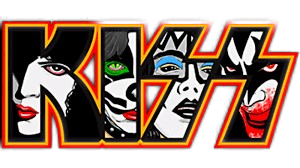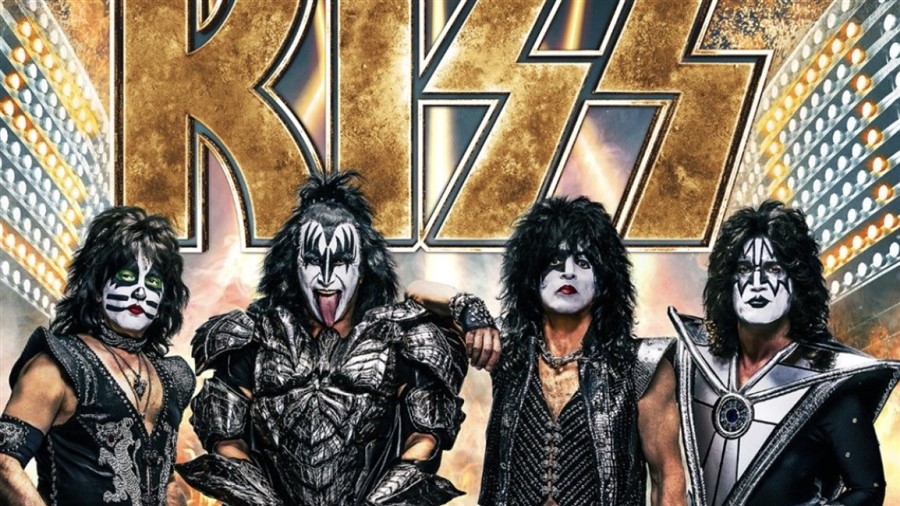
Kiss was an American Rock band formed in New York City in 1973 by Paul Stanley (vocals, rhythm guitar), Gene Simmons (vocals, bass), Ace Frehley (lead guitar, vocals) and Peter Criss (drums, vocals). Known for their face paint and stage outfits, the group rose to prominence in the mid-1970s with Shock rock-style live performances. The band went through several lineup changes, with Paul Stanley and Gene Simmons remaining the only consistent members. The final lineup consisted of them, Tommy Thayer (lead guitar, vocals) and Eric Singer (drums, vocals).
The band members took on the personas of comic book-style characters: the Starchild (Stanley), the Demon (Simmons), the Spaceman or Space Ace (Frehley), and the Catman (Criss). Kiss became one of America's most successful rock bands and a pop culture phenomenon during the second half of the 1970s. Due to creative differences, Peter Criss departed the band in 1980, followed by Ace Frehley in 1982. They were replaced by Eric Carr (the Fox) and Vinnie Vincent (the Ankh Warrior), respectively.
The band's commercial success had declined during the early 1980s before experiencing a resurgence in 1983, when they began performing without makeup and costumes, marking the beginning of the band's "unmasked" era that would last until 1996. Vinnie Vincent left the band in 1984, being replaced briefly by Mark St. John before Bruce Kulick joined the band for the next twelve years. Eric Carr died in 1991 of heart cancer and was replaced by Eric Singer.
In response to a wave of Kiss nostalgia in the mid-1990s, the original lineup reunited in 1996, which also saw the return of their makeup and stage costumes. The resulting 1996–1997 reunion tour was highly successful, grossing $143.7 million, making it the band's most successful tour. Peter Criss and Ace Frehley subsequently left the band again following the 2000–2001 tour, which at the time was intended to be Kiss' last. Criss and Frehley were replaced by Eric Singer and Tommy Thayer (Criss briefly rejoined the band from 2002 to 2004), respectively. In a move which proved controversial among fans, Singer and Thayer adopted the original Catman and Spaceman makeup respectively, rather than having their own unique makeup designs. After 46 years of recording and performing, Kiss began a four-year-long farewell tour, the End of the Road World Tour, in January 2019 and retired after performing their final show in New York City in December 2023.
Kiss is regarded as one of the most influential rock bands of all time, as well as one of the best selling bands of all time, claiming to have sold more than 75 million records worldwide, including 21 million RIAA-certified albums. Kiss has also earned 30 Gold albums, the most of any band from the United States. Kiss has 14 Platinum albums, three of which earned multi-Platinum. On April 10, 2014, the four original members of Kiss were inducted into the Rock and Roll Hall of Fame. Kiss was ranked by MTV as the ninth "Greatest Metal Band of All Time", and placed tenth on VH1's "100 Greatest Artists of Hard Rock" list, as well as being ranked as the third "Best Metal and Hard Rock Live Band of All Time" by Loudwire magazine.
Early years 1971-1975
Kiss traces its roots to Wicked Lester, a New York City–based rock band led by Gene Simmons and Paul Stanley. That band recorded one album, which was shelved by Epic Records, and played a handful of live shows. Simmons and Stanley, feeling a new musical direction was needed, abandoned Wicked Lester in 1972 and began forming a new group.
After breaking up Wicked Lester late in 1972, Simmons and Stanley came across an ad in the East Coast version of Rolling Stone placed by Peter Criss, a drummer from the New York City scene who had previously played in the bands Lips and Chelsea. Simmons and Stanley met Criss in a nightclub where he was playing drums. After hearing Peter Criss sing, they thought he should be in the new band they were forming. Criss then auditioned for, and later joined their new band. The three focused on a much harder style of Rock than that played by Wicked Lester. In November 1972, the band played a showcase for Epic Records A&R director Don Ellis, in an effort to secure a record deal.
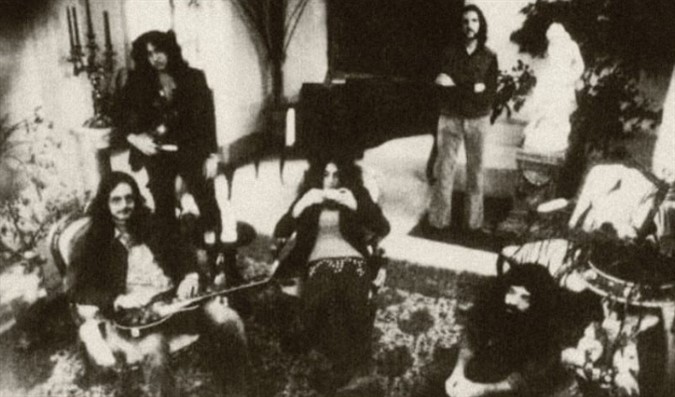
In early January 1973, the group added lead guitarist Ace Frehley. Frehley impressed the group with his first audition, and was asked back for a second audition. A few weeks after Frehley joined, the classic lineup was solidified as the band to be named Kiss. They also began experimenting with their image, by wearing makeup and various outfits.
Paul Stanley came up with the name while he, Gene Simmons, and Peter Criss were driving around New York City. Criss mentioned that he had been in a band called Lips, so Stanley said something to the effect of "What about Kiss?" Ace Frehley created the now-iconic logo, making the "SS" look like lightning bolts, when he went to write the new band name over "Wicked Lester" on a poster outside the club where they were going to play. (Some of Wicked Lester's artwork included one lightning bolt for the "S" in Lester.) Later, Stanley designed the logo with a Sharpie and a ruler and accidentally drew the two S's nonparallel because he did it "by eye". The art department asked him if he wanted it to be redrafted to be perfect and he said, "It got us this far, let's leave well enough alone. Our number one rule has always been no rules."
The letters happened to look similar to the insignia of the Nazi SS, a symbol that is outlawed in Germany by Section 86a of the German criminal code. However, Simmons and Stanley, both Jewish, have denied any intentional likeness to Nazi symbolism in the logo. Since 1979, most of the band's album covers and merchandise in Germany have used a different logo, in which the letters "SS" look like the letters "ZZ" backwards. This logo is also used in Austria, Switzerland, Lithuania, and Hungary to avoid controversy.
The band's name has repeatedly been the subject of rumors pertaining to alleged hidden meanings. Among these rumors are theories that the name is an acronym for "Knights in Satan's Service", "Kinder SS", or "Kids in Satan's Service". Simmons has denied all of these claims.
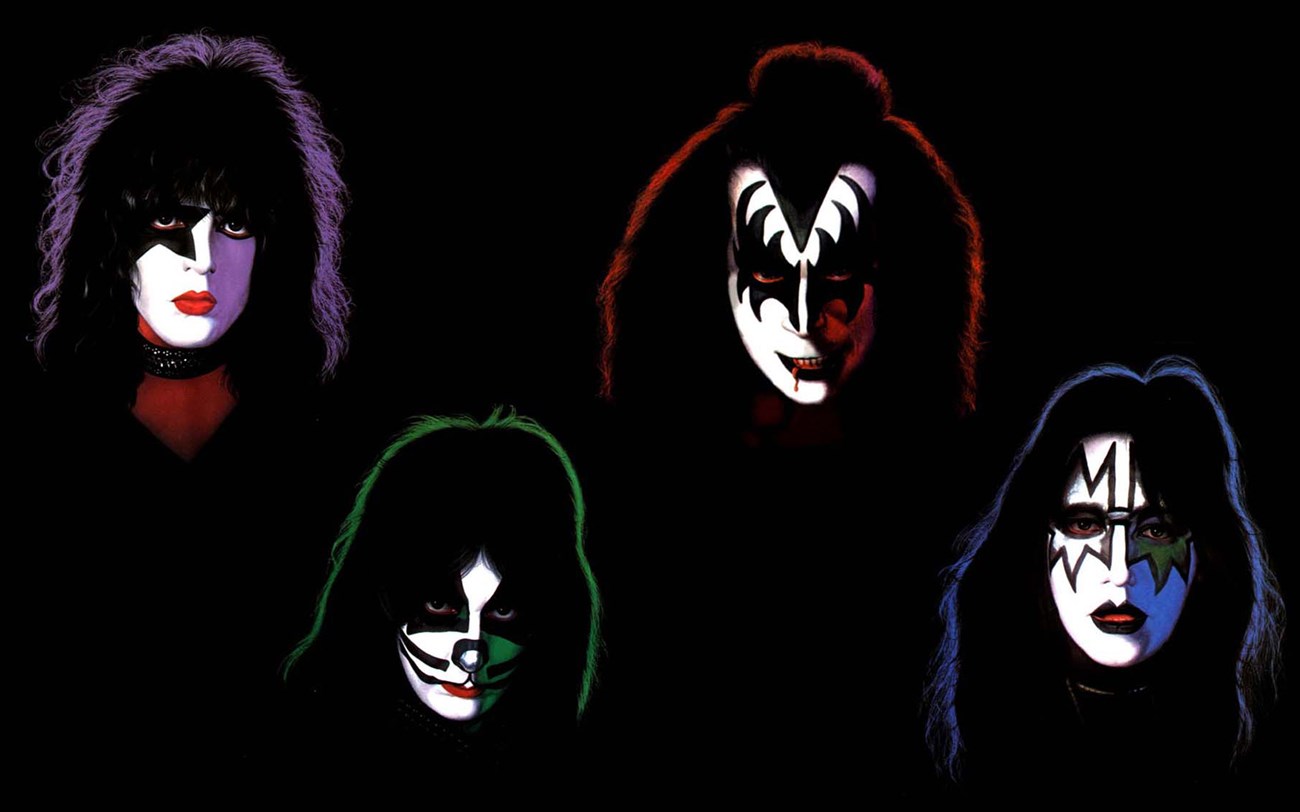
The first Kiss performance took place on January 30, 1973, for an audience of fewer than ten people at the Popcorn Club (renamed Coventry shortly afterward) in Queens. The band was paid $50 for performing two sets that evening, following a cold-call Simmons had made to the venue, convincing them to hire the new band for a three-night stand. For the first three gigs, January 30 to February 1, they wore makeup, but the iconic character designs associated with Kiss made their debuts during the March 9–10 shows at The Daisy in Amityville, New York.
"Our first show ever was at Coventry. Coventry was a study in contrasts. The first time we played there was nobody there. The last time we played there, you could barely get in the door." — Paul Stanley
On March 13 of that year, the band recorded a five-song demo tape with producer Eddie Kramer. Former TV director Bill Aucoin, who had seen the group at a handful of showcase concerts in the summer of 1973, offered to become the band's manager in mid-October.
Kiss agreed, with the condition that Aucoin signed the band to a record label within two weeks. On November 1, 1973, Kiss became the first act signed to former teen pop singer and Buddah Records executive Neil Bogart's new label, Casablanca Records.
The band entered Bell Sound Studios in New York City on October 10, 1973, to begin recording its first album. On December 31, the band had its official industry premiere at the Academy of Music in New York City, opening for Blue Öyster Cult. It was at this concert that, for the first of many times, Simmons accidentally set his hair (which was coated in hairspray) ablaze while performing his fire-breathing routine.
Kiss's first tour started on February 5, 1974, in Edmonton, Alberta, a cafeteria at the Northern Alberta Institute of Technology, as an opening act. The band's self-titled debut album was released on February 18. Casablanca and Kiss promoted the album heavily throughout the spring and summer of 1974.
"Being in Kiss in the very first year and touring around the United States, we felt like we were taking off. It was like somebody pushing you into the deep end of the pool whether you can swim or not. The early years of Kiss were far from glamorous. We rode in a station wagon hundreds of miles every day. We would take turns driving and sleeping in the back. We ate burgers at roadside taverns. We stopped and peed on the side of long stretches of a highway when we couldn't find a town anywhere near. We ate beans and franks because we couldn't afford better food as we were on an $85 a week salary! Becoming a rock star was better than anything and beyond anything I ever imagined. There were moments of doubt for me that we were gonna make it." — Gene Simmons
On February 19, in its first television appearance, the band performed "Nothin' to Lose", "Firehouse" and "Black Diamond" on ABC's In Concert (aired March 29). On April 29, the band performed "Firehouse" on The Mike Douglas Show. This broadcast included Simmons's first televised interview, a conversation with Mike Douglas in which Simmons declared himself "evil incarnate", eliciting uncomfortable reactions from a confused studio audience. Fellow Jewish-American guest Totie Fields said it would be humorous if beneath all the makeup Simmons was "just a nice Jewish boy". Simmons responded, "You should only know", to which Fields replied, "I do. You can't hide the hook", a reference to the stereotypical "Jewish" nose.
Despite the publicity and constant touring, Kiss initially sold just 75,000 copies. Meanwhile, the group and Casablanca Records were losing money quickly. The band (while touring) stopped in Los Angeles in August 1974 to begin recording its second album, Hotter Than Hell, which was released on October 22, 1974. The only single, "Let Me Go, Rock 'n' Roll", failed to chart, and the album stalled at No. 100.
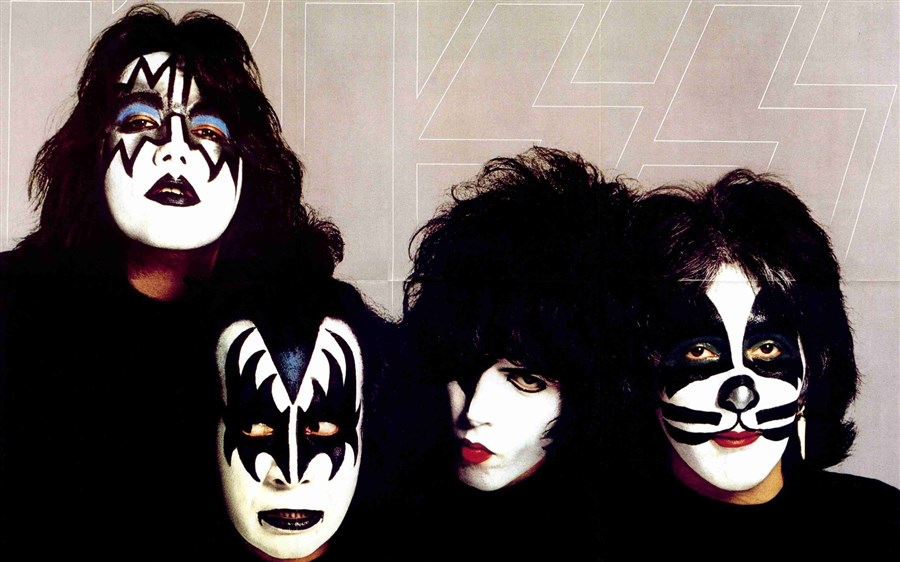
With Hotter Than Hell quickly dropping off the charts, Kiss was pulled from its tour to quickly record a new album. Casablanca head Bogart stepped in to produce the next album, trading in the murky, distorted sound of Hotter Than Hell for a cleaner and slightly poppier sound. Dressed to Kill, released on March 19, 1975, fared slightly better commercially than Hotter Than Hell. It also contained what later became the band's signature song, "Rock and Roll All Nite".
Although Kiss albums had not proved to be big sellers, the band was quickly gaining a reputation for its live performances. Kiss concerts featured such spectacles as Gene Simmons spitting "blood" (an effect made primarily from eggs, yogurt, red food coloring, and maple syrup) and "breathing fire" (spitting flammable liquid at a torch), Ace Frehley soloing as his guitar burst into flames (light and smoke bombs placed inside the guitar), Peter Criss's elevating drum riser that emitted sparks, Stanley's Pete Townshend-style guitar smashing, and pyrotechnics throughout the show.
By mid-1975, Casablanca was almost bankrupt, and Kiss was in danger of losing its record contract. Both parties desperately needed a commercial breakthrough if they were to survive. That breakthrough came in an unlikely form: the double live album, Alive!.
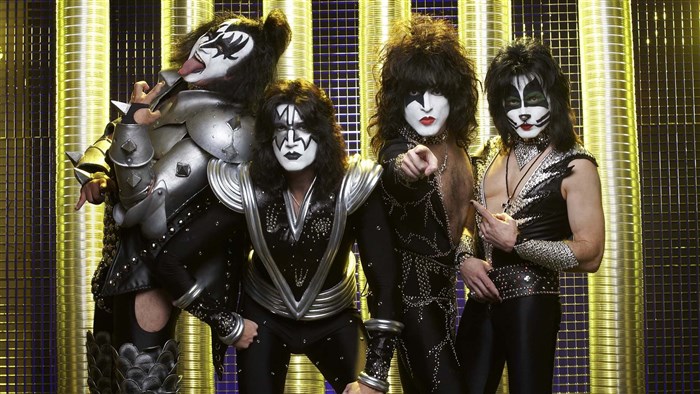
Rise to prominence 1975-1978
"I saw a pattern emerging with us on the road. Every night, I'd ask somebody before the show, "How are we doing?", which meant, "What's the attendance?" One night they said, "It's sold out," and then the next night I'd hear the same thing. All of a sudden it was becoming the norm. For me the first realization that things were on an upswing was when we played the Hara Arena in Dayton, Ohio. Before the show I went on stage, looked out through the curtain and saw this big crowd, and said to myself, "My God, this is really happening!" —Paul Stanley
Kiss wanted to express the excitement felt at its concerts (which its studio albums had so far failed to do) with its first live album. Compiled from concerts recorded between May and July in Wildwood, New Jersey, Detroit and Cleveland, and released on September 10, 1975, Alive! achieved Gold status and spawned Kiss's first top 40 single: a live version of "Rock and Roll All Nite".
It was the first version of the song with a guitar solo, and this recording has become the best-known version. It is also the basis of most covers, such as the cover by Poison in 1987. In recent years the band admitted that additional audience noise had been added to the album, as well as overdubs on select guitar and vocal spots, not to deceive fans, but to add more "excitement and realism" to the record.
The success of Alive! not only brought Kiss the breakthrough they had been seeking but arguably saved Casablanca, which was close to bankruptcy. Following this success, Kiss partnered with producer Bob Ezrin, who had previously worked with Alice Cooper. The result was Destroyer (released March 15, 1976), Kiss's most musically ambitious studio album to date. Destroyer, with its rather intricate production (using an orchestra, choir, and numerous tape effects), was a departure from the raw sound of the first three studio albums. Album art was designed by Ken Kelly, who had drawn Tarzan and Conan the Barbarian and also produced album covers for acts such as Rainbow and Manowar. While the album sold well initially and became the group's second Gold album, it quickly dropped down the charts. Only when the ballad "Beth", the B-side of the single "Detroit Rock City", began to gain more airplay on FM radio did the album's sales rebound. The single was subsequently reissued with the A- and B-sides reversed. "Beth" peaked at No. 7 on the Billboard Hot 100, becoming the band's first Top 10 single in the United States.
In October 1976, Kiss appeared on The Paul Lynde Halloween Special (aired on ABC the 29th), lip-synching "Detroit Rock City", "Beth" and "King of the Night Time World". The show, co-produced by Bill Aucoin, helped introduce Kiss to an even wider audience. In addition to the three songs, Kiss was the subject of a brief comedic "interview" conducted by Paul Lynde. This included Lynde noting, when hearing the member's first names, "Oh, I love a good religious group."
Two more highly successful studio albums were released in less than a year: Rock and Roll Over (November 11, 1976) and Love Gun (June 30, 1977). A second live album, Alive II, was released on October 14, 1977. All three albums were certified Platinum soon after their release. Between 1976 and 1978, Kiss earned $17.7 million from record royalties and music publishing. A 1977 Gallup poll named Kiss the most popular band in America. In Japan, Kiss performed five sold-out shows at Tokyo's Budokan Hall, equaling the record set by The Beatles in 1966 with their five concerts there.
"When we played in Japan in the late '70s, nothing could prepare you for the hysteria because when people are telling you how big you are, you're big compared to what? Until you're faced with mass hysteria it doesn't really sink in. For you not having been in a certain country makes them that much more rabid for you to go." — Paul Stanley
In May 1977, Kiss made the first of its many comic book appearances, in Howard the Duck issue 12, published by Marvel Comics.
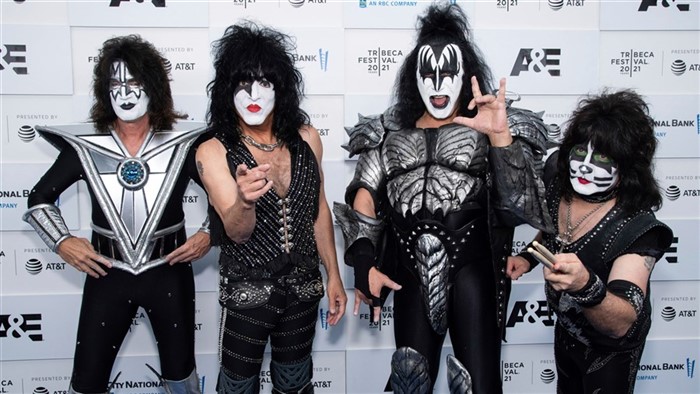
The first Kiss compilation album, Double Platinum, was issued on April 2, 1978. This double album included many remixed versions of the band's hits, as well as "Strutter '78", a re-recorded version of a song from the group's first album. At Bogart's request, this version of the song featured a disco influence.
During this period, Kiss merchandise became a substantial source of income for the group. Some of the products released included a pair of comic books issued by Marvel (the first contained ink mixed with actual blood donated by the group), a pinball machine, dolls, "Kiss Your Face Makeup" kits, Halloween masks, board games, lunch boxes, trading cards and many other pieces of memorabilia. Membership in the Kiss Army, the band's fan club, was in the six figures. Between 1977 and 1979, worldwide merchandise sales (in-store and on tour) reached an estimated $100 million.
Solo and film projects 1978
Alive II was the band's fourth Platinum album in just under two years, and the ensuing tour had the highest average attendance in the group's history. In addition, Kiss's gross income for 1977 was $10.2 million. The group, along with manager Aucoin, sought to push the brand harder. To that end, an ambitious, two-pronged strategy was devised for 1978.
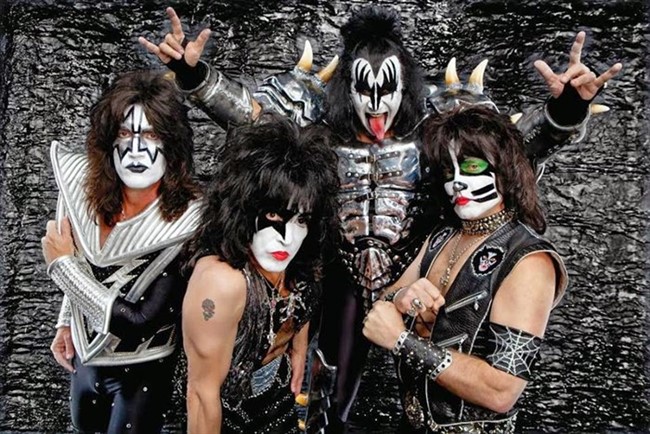
The first part involved the simultaneous release of four solo albums from the members of Kiss. Although Kiss has claimed that the solo albums were intended to ease rising tensions within the band, its 1976 record contract did in fact call for four solo records, each of them counting as half an album toward the group's five-record commitment. Each album was a solo effort (none of the group appeared on another's album), however all were released and marketed as Kiss albums (with similar cover art and poster inserts). It was the first time that all current members of a rock band had released solo albums on the same day.
For the band members, it was a chance to showcase their individual musical styles and tastes outside of Kiss, and in some cases to collaborate with contemporary artists. Paul Stanley's and Ace Frehley's albums were most similar to Kiss's Hard rock-style, while Peter Criss' album featured an R&B style including ballads. Gene Simmons' was the most diverse of the four, featuring hard rock, ballads, Beatles-influenced pop and a cover version of "When You Wish Upon a Star" from the Disney film Pinocchio. Simmons' many collaborators included Aerosmith's Joe Perry, Cheap Trick's Rick Nielsen, The Doobie Brothers' Jeff "Skunk" Baxter, Donna Summer, Janis Ian, Helen Reddy, Bob Seger, Katey Sagal, and his then-girlfriend Cher.
The solo albums were released on September 18, 1978. Casablanca Records spent $2.5 million on the marketing campaign for the albums, and announced they were shipping five million copies, guaranteeing Platinum status. Despite the large shipments, none of the albums sold particularly well and were later sold as cut-outs. Of the four, Simmons's album charted the highest in the U.S., peaking at #22, while Frehley's spawned the only resulting Top Forty hit single, a cover of "New York Groove", written by Russ Ballard and originally performed by Hello. Frehley's album has gone on to be the biggest seller since the introduction of Nielsen Soundscan in 1991.
The second part of Kiss's and Aucoin's plan called for the band to appear in a film that would cement its image of larger-than-life rock-and-roll superheroes. Filming commenced in the spring of 1978. Although the project was proposed to the band as a cross between A Hard Day's Night and Star Wars, the final result fell far short of those expectations. The final product, Kiss Meets the Phantom of the Park, debuted on NBC on October 28, 1978. It was released theatrically, after many changes, outside the U.S. in 1979 under the title Attack of the Phantoms. The band members were unhappy with the finished film and would speak about their filmmaking experience in later interviews with a mix of humorous embarrassment and regret. They felt that the film portrayed them more as clowns than superheroes. The artistic failure of the film led to a rift between the band and Bill Aucoin.
Final makeup years 1979-1983
Kiss's first album of new material in two years, Dynasty (1979), continued the band's Platinum streak. The disco-flavored "I Was Made for Lovin' You" became one of the band's biggest hit singles to date, peaking at No. 11. Session drummer Anton Fig performed almost all the percussion on the album while Peter Criss recovered from an automobile accident. The only song to feature Criss's drumming was "Dirty Living'", on which he also sang lead. The album is also notable due to Ace Frehley singing three lead vocals versus Simmons two, which he put down to increased confidence following the success of his solo album.
Billed as "The Return of Kiss", the Dynasty Tour was expected by Kiss and their management to build on the success of previous tours. Plans were drawn up for a Kiss-themed traveling amusement park called "Kiss World", but were abandoned because of the immense costs involved; however, "The Return of Kiss" saw a marked decline in attendance. The crowds on this tour were much younger than previous audiences had been, with many preadolescent children in Kiss makeup with their mothers and fathers,
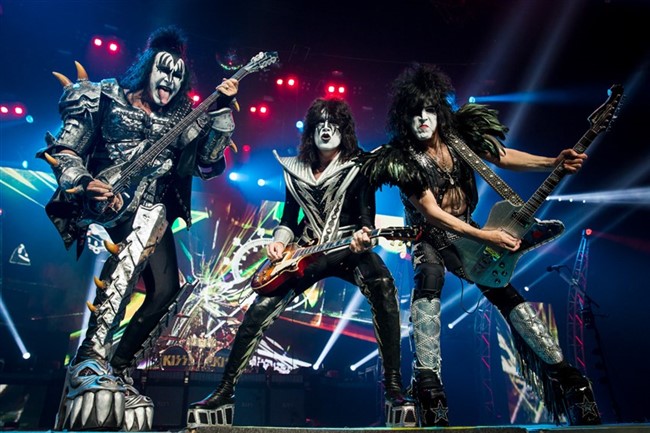
(who were sometimes wearing the makeup themselves) in tow at most concerts. Kiss themselves did little to dissuade this new fan base, donning colorful costumes that reinforced a cartoonish image for these younger fans.
The fans were unaware of the dissension within the band. One very public indication of the heightened friction within the group was an infamous October 31, 1979, interview on Tom Snyder's late-night The Tomorrow Show. During the episode, a visibly irritated Gene Simmons and Paul Stanley attempted, unsuccessfully, to contain the inebriated Ace Frehley, whose frequent laughter and joking overshadowed the conversation between Tom Snyder and the rest of the band. Peter Criss made references to his large gun collection, to the chagrin of Simmons.
By the end of the Dynasty tour in December 1979, tensions between Criss and the rest of the band were at an all-time high. His drumming skills had noticeably eroded, and he even intentionally slowed down—or stopped playing altogether—during some concerts. The final show of the tour (December 16, 1979) was the last time Peter Criss performed with the group for almost 17 years, although he remained an official member for nearly six more months.
While Criss appeared on the cover of the next album, Unmasked, Anton Fig was the actual drummer, although he was not credited. Showcasing a slick, contemporary pop sound, Unmasked (released May 20, 1980) had the dubious distinction of being the first non-Platinum Kiss album since Dressed to Kill. Soon after the album's release, Criss's departure was officially announced. Fig, considered a member of Kiss for one day following the departure of Criss, was then fired by Stanley and Simmons, who felt he was not a good fit for the band. He would ultimately join Paul Shaffer and the World's Most Dangerous Band, acting as the drummer for David Letterman's television programs until the host's retirement.
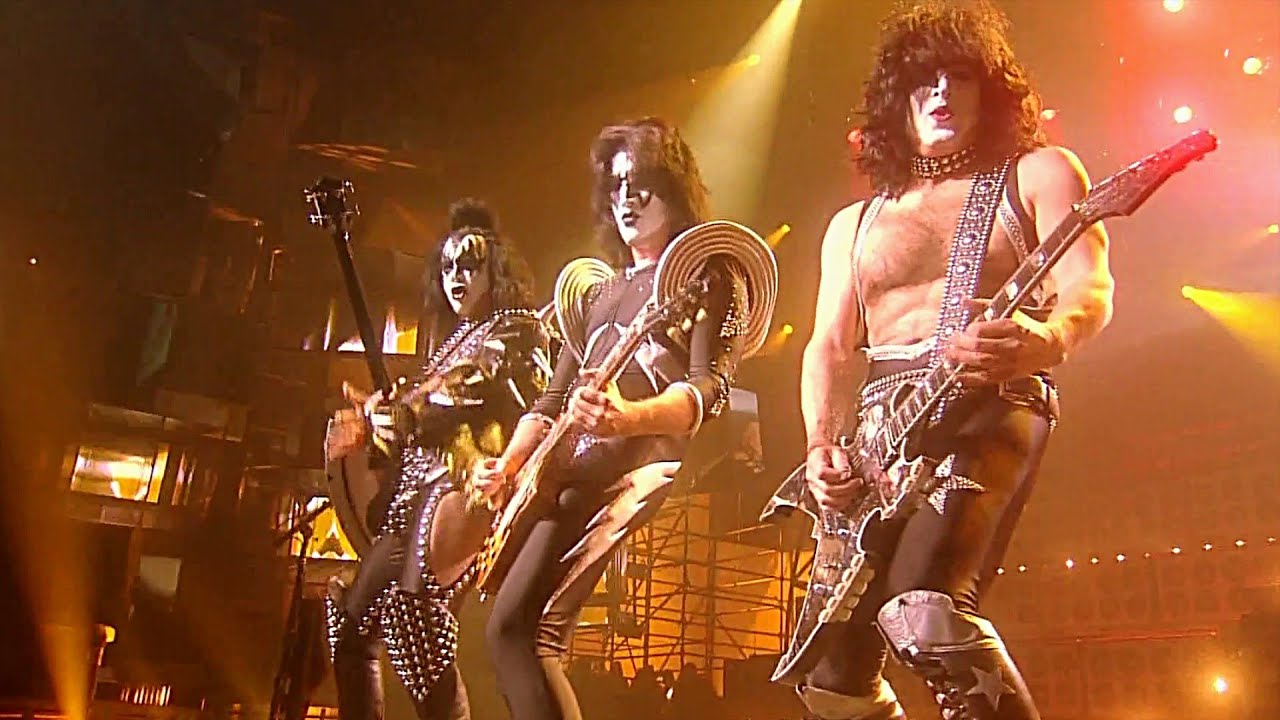
The band auditioned dozens of replacements for Peter Criss in June 1980. One of the many who auditioned was Tico Torres (who would later be with Bon Jovi). They finally settled on a little-known drummer-guitarist-pianist-keyboardist-singer from Brooklyn named Paul Charles Caravello (born July 12, 1950) who adopted the stage name Eric Carr. His first makeup design was modeled on a hawk, though it was rejected when Paul Stanley and Bill Aucoin saw Carr in the bright yellow costume Kiss had designed for the new drummer.
Carr created the "Fox" persona by the middle of July. In his Fox makeup, Carr debuted with the group on July 25, 1980, at the Palladium concert hall in New York City. This was Kiss's only U.S. show in support of Unmasked. On July 30, 1980, Kiss introduced Carr on ABC's Kids Are People Too!, which would air in September. The band's 1980 tour of Australia and New Zealand, on the other hand, was one of the biggest in its history, as they played to sold-out crowds and received overwhelmingly positive press coverage.
For its next album, the band worked again with producer Bob Ezrin, with whom Kiss had found success on Destroyer. Early press reports indicated that the new album would be a return to the Hard rock style that had originally brought the band success. However, 1981's Music from "The Elder" was a concept album featuring medieval horns, strings, harps, and synthesizers.
The album was presented as a soundtrack to a film that was never made, making it difficult to follow the storyline. To make matters worse, having received negative feedback following its record company's preview of the album, Kiss altered the record's track sequence in most countries to emphasize potential singles "The Oath" and "A World Without Heroes", which all but guaranteed the inability of listeners to understand the already-muddled storyline. Once released, fan reaction to The Elder was harsh; it failed to achieve Gold status and peaked at No. 75 on the Billboard album chart.
The band made only two appearances in support of the new album, both in January 1982. One was a performance on the ABC late-night variety program Fridays, while the second was a lip-synced performance that was broadcast via satellite during Italy's Sanremo Music Festival.
Absent from the satellite performance was Ace Frehley, who had become increasingly frustrated with Kiss's new musical direction. Upset with the band's decision to record Music from "The Elder", he did not actively participate in the album's creation, providing lead vocals for only one track, "Dark Light". He did not appear at a special concert at Studio 54 in New York City, leaving Kiss to perform as a trio. He recorded his guitar parts at his home studio in Wilton, Connecticut, and mailed them to Bob Ezrin. Another source of frustration for Frehley was that with the departure of Peter Criss, and with Eric Carr not being an equal partner in the band, he was often outvoted 2-to-1 on group decisions. In June 1982, Frehley's departure from the band was negotiated, although he did not officially leave until December.
Gene Simmons stated in his autobiography Kiss and Make-Up that Van Halen founder Eddie Van Halen was eager to replace Ace Frehley as Kiss's lead guitarist. Simmons and Eddie's brother Alex convinced Eddie to remain with Van Halen. Eddie was willing to break up Van Halen due to tensions between himself and lead vocalist David Lee Roth, who ultimately left the band in 1985. Paul Stanley, however, has since denied the rumors of Eddie Van Halen wanting to join Kiss. Other notable guitarists who auditioned to replace Frehley included Punky Meadows of Angel, Doug Aldrich of Whitesnake, Richie Sambora of Bon Jovi, Yngwie Malmsteen, and Slash of Guns 'N' Roses.
Soon afterward, Kiss made major changes to its business dealings – chief among them was severing ties with its manager of nine years, Bill Aucoin, and cutting back on its unwieldy organizational tree. Although Frehley had already decided to leave the band, he was pictured on the covers of 1982's Killers and Creatures of the Night, although he did not participate in the recording of either album. Creatures of the Night (October 13, 1982) was Kiss's heaviest album to date, and although it fared better than Music from "The Elder", it peaked at only No. 45 on the charts and was not certified Gold until 1994.
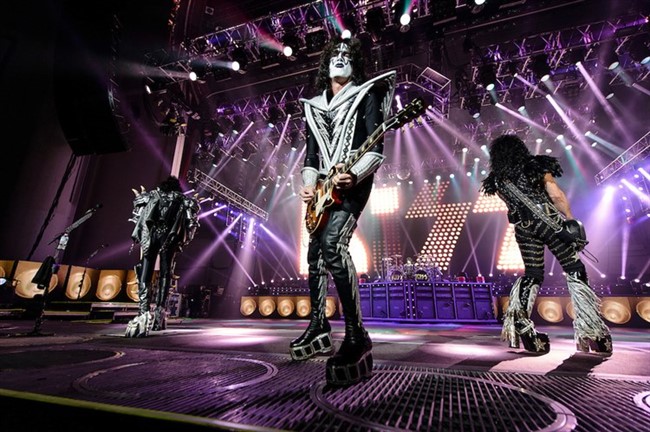
In Frehley's absence, Kiss utilized a number of guitarists for the recording of the album, including Vinnie Vincent.
Ace Frehley's last appearance with the band (until the 1996 reunion) was in the music video for the single "I Love It Loud", which was co-written by Vinnie Vincent. Frehley also appeared on the cover of the original Creatures of the Night album artwork. When the album was remixed and re-released in 1985 with a non-makeup cover and a slightly different song order, to reflect the band's roster change and abandonment of its makeup and costumes, Vincent was again absent from the album cover, as then-current lead guitarist, Bruce Kulick, appeared instead. The liner notes accompanying the remixed LP, however, credited both Frehley and Vincent with lead guitar performances on the Creatures of the Night album. Vincent officially replaced Frehley as lead guitarist in December 1982, as the band embarked on its 10th Anniversary Tour.
Vinnie Vincent originally wanted to use his birth name (Cusano) in the band, but this was vetoed by Gene Simmons on the grounds that it sounded "too ethnic". Specifically, according to Simmons, "it sounded like a fruit vendor". Simmons went on to note that "fairly or unfairly, Rock and roll is about the image". Vincent then suggested the name "Mick Fury", but this was also disallowed. Simmons later suggested the name change to "Vinnie Vincent". Vincent started actively pushing to join Kiss as a full member. Despite the misgivings that both Simmons and Stanley harbored about his personality, Vincent was taken into the band. Paul Stanley designed a character, "the Wiz" also known as "the Egyptian Warrior", and makeup centered around an Egyptian ankh, for Vincent. According to the official authorized Kiss biography, written by David Leaf and Ken Sharp, "the Egyptian Ankh Warrior" refers to Vincent's makeup and persona, while the nickname "the Wiz" refers to his virtuosity as a guitar player. According to the Simmons autobiography Kiss and Make-Up, Vincent's Kiss persona was solely "the Wiz". A persona as "the Ankh Warrior" or similar is not mentioned in the book at all.
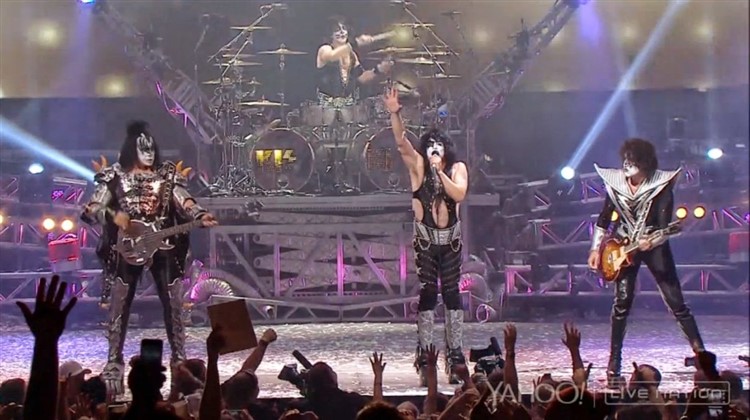
From 1982 to 1983, the new lineup of Kiss became Gene Simmons (the Demon), Paul Stanley (the Starchild), Eric Carr (the Fox) and Vinnie Vincent (the Egyptian Warrior) or the Wiz.
Vincent's personality did not mesh well with either Stanley or Simmons, and he was dismissed from Kiss at the end of the Creatures tour. He was quickly reinstated before recording started for Lick It Up because Simmons and Stanley could not find a new lead guitarist on such short notice. Vincent appeared on the cover of Lick It Up and was credited as the lead guitarist. He received a writing credit for eight of the ten songs on the album.
Personality issues arose once again, and Vincent was fired following the Lick It Up tour, due in part to excessive guitar soloing at a 1984 concert in Quebec. He was replaced by Mark St. John. Vincent was later utilized by Kiss as a songwriter on the 1992 album Revenge,
contributing to the songs "Unholy", "Tough Love", "Heart of Chrome" and "I Just Wanna". Vincent and the band parted ways. Persistent rumors circulated for years among Kiss fans regarding the true reason for Vincent's dismissals from Kiss, with at least one band member refusing to comment except to say that legally it was not up for discussion. Simmons stated in an interview several years later that Vincent's firing was for "unethical behavior", but he did not elaborate:
Vinnie, for the record, was fired for unethical behavior, not because of lack of talent.
Unmasking 1983-1996
Sensing it was time for a change, Kiss made the decision to abandon their trademark makeup and costumes. The band officially appeared in public without makeup for the first time since their very early days on a September 18, 1983, appearance on MTV, which coincided with the release of Lick It Up. The tour to promote the new album and the unmasked band members began in Lisbon, Portugal, on October 11, 1983, at Pavilhão Dramático de Cascais, the band's first concert without makeup since early 1973. Lick It Up became Kiss's first Gold record in three years, but the tour was even more sparsely attended than the previous one. Vincent did not get along with Simmons and Stanley, and he left the band at the conclusion of the tour in March 1984. Vincent's replacement was Mark St. John, a session player and guitar tutor.
With St. John, Kiss released the album Animalize on September 13, 1984. Animalize followed the success of Lick It Up, and due in part to consistent MTV play for the "Heaven's on Fire" video, Animalize was the band's bestselling record in America during the decade, with over two million albums sold. With the success of the album and subsequent tour, Kiss had recaptured some of its earlier glory (though not to the level of its 1970s heyday). Mark St. John, however, came down with reactive arthritis during tour rehearsals, and only performed at a handful of shows before being dismissed from the band in December 1984, with one of these shows being at the Mid-Hudson Civic Center in Poughkeepsie, New York which was recorded on November 28, 1984. The band hired Bruce Kulick to replace St. John. Kulick had previously filled in for St. John during the first two months of the Animalize tour. Bruce Kulick was Kiss's fourth lead guitarist in less than three years, but he stayed with the band for 12 years. Kulick became one of the band's longest-serving members, with the longest continuous tenure of anyone other than Simmons and Stanley, until Tommy Thayer and Eric Singer broke his record in 2014 and 2016 respectively.
"You can't help but have a good time at one of our shows when everybody is going nuts onstage. That kind of good time is infectious. You can't fake it. You can't fool the audience. The people will see right through you if you put on a fake smile or you're not putting out your best. The band are alive and well and playing better than we ever have." — Gene Simmons
One of the first concerts Bruce Kulick played as an official member of the band was at Detroit, Michigan's Cobo Hall. It was filmed for the MTV special Animalize Live.
The lineup of Paul Stanley, Gene Simmons, Eric Carr and Bruce Kulick turned out to be the most stable since the original, and for the rest of the 1980s, Kiss released a series of Platinum albums: 1985's Asylum, 1987's Crazy Nights and the 1988 greatest hits compilation Smashes, Thrashes & Hits. Crazy Nights, in particular, was one of Kiss's most successful albums overseas. The single "Crazy Crazy Nights" reached No. 4 on the singles chart in the United Kingdom, the band's highest-charting single in that country. Kiss ended the decade with the October 1989 release Hot in the Shade. Although the album failed to achieve Platinum status, it spawned the hit ballad "Forever", co-written by Michael Bolton.
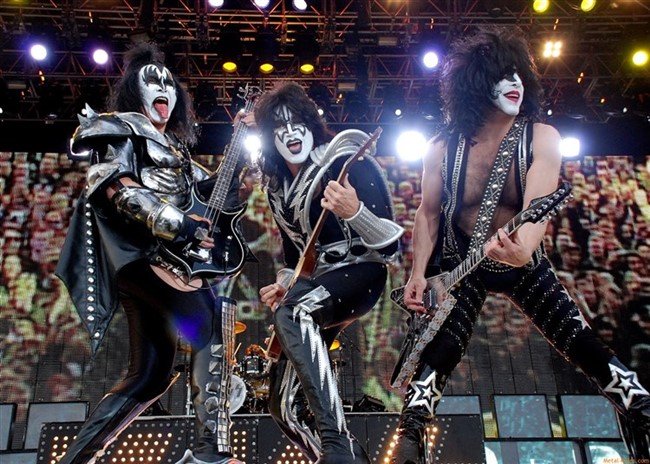
Peaking at No. 8 in the US, it was the group's highest-charting single since "Beth" and was the band's second Top 10 single.
During this time, Kiss struggled with its identity and fan base. Gene Simmons, arguably the driving force in Kiss during the 1970s, became less involved with the group in the 1980s as he pursued outside interests, most notably a film career. Paul Stanley took a more prominent role as a result.
In February 1991, the band decided to once again enlist Bob Ezrin to produce its next album. Before recording could begin in earnest, however, tragedy struck. In March 1991, it was discovered that Eric Carr had a tumor on his heart. It was successfully removed the following month, but more tumors were soon discovered in his lungs. Carr received chemotherapy and was pronounced cancer-free in July. However, in September he suffered the first of two cerebral hemorrhages. He died on November 24, 1991, at the age of 41.
Despite the tragic loss of a longtime member, Kiss continued, introducing veteran drummer Eric Singer (born Eric Doyle Mensinger on May 12, 1958, in Cleveland, Ohio). Singer had played with Paul Stanley previously, as part of Stanley's backing band during a 1989 solo tour.
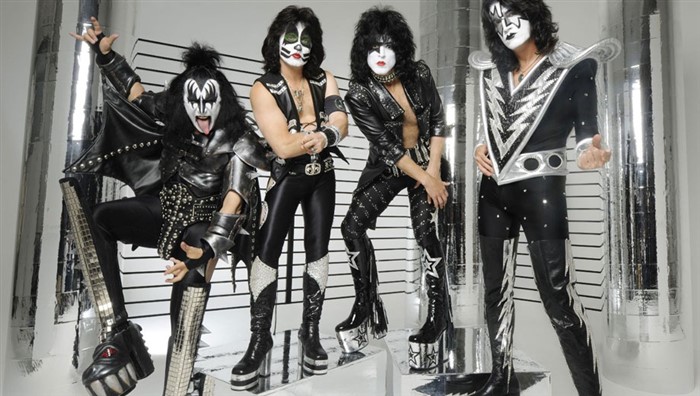
Kiss released Revenge on May 19, 1992. It featured a leaner, harder-edged sound, as indicated by the first single, "Unholy". In a surprise move, Kiss enlisted Vinnie Vincent to help with songwriting duties. The album debuted in the Top 10 and went Gold. Kiss embarked on a brief club tour of the U.S. in the spring of 1992, before beginning an American tour in September 1992. The tour was documented on the album Alive III, released on May 14, 1993. Four days later, Kiss were inducted into Hollywood's RockWalk.
In 1995, the group released the book Kisstory, a 440-page, 9 pounds (4.1 kg), detailed chronicle of the group's history to that point. That same year, the band embarked on a unique and well-received Worldwide Kiss Convention Tour. The conventions were all-day events, featuring displays of vintage Kiss stage outfits, instruments and memorabilia; performances by Kiss cover bands; and dealers selling Kiss merchandise from every stage of the band's career. Kiss appeared live at the conventions, conducted question and answer sessions,
signed autographs, and performed a two-hour acoustic set composed mostly of spontaneous fan requests. On the first U.S. date (June 17, 1995), Peter Criss appeared onstage with Kiss to sing "Hard Luck Woman" and "Nothin' to Lose". It was the first time Criss had performed publicly with the band in nearly 16 years.
Original lineup reunion tour and remasking 1996-2001
On August 9, 1995, Kiss joined the long line of musicians to perform on MTV Unplugged. The band contacted Peter Criss and Ace Frehley and invited them to participate in the event. Both joined Kiss on stage for several songs at the end of the set: "Beth", "2000 Man", "Nothin' to Lose" and "Rock and Roll All Nite". The Unplugged appearance set off months of speculation that a possible reunion of the original Kiss lineup was in the works. In the weeks following the Unplugged concert, however, the band (with Kulick and Singer) returned to the studio for the first time in three years to record a follow-up to Revenge. Carnival of Souls: The Final Sessions was completed in February 1996, but its release was delayed for almost two years. Bootleg copies of the album circulated widely among fans. While Kiss continued to exist publicly as Simmons, Stanley, Kulick and Singer, arrangements for a reunion of the original lineup were in the works. These efforts culminated with a public event as dramatic as any the band had staged since its 1983 unmasking on MTV. With the following statements, Tupac Shakur introduced the original Kiss lineup, in full makeup and Love Gun-era stage outfits, to a rousing ovation at the 38th Annual Grammy Awards:
"You know how the Grammys used to be, all straight-looking folks with suits. Everybody looking tired. No surprises. We tired of that. We need something different, something new, we need to shock the people ... so let's shock the people!"
On April 16, the band members held a press conference aboard the USS Intrepid in New York City, where they announced their plans for a full-fledged reunion tour, with the help of new manager Doc McGhee. The conference, MC'd by Conan O'Brien, was simulcast to 58 countries. On April 20, nearly 40,000 tickets for the tour's first show sold out in 47 minutes. The first public concert featuring the newly reunited Kiss was an hour-long warm-up show on June 15 for the annual KROQ Weenie Roast in Irvine, California, during which the band nearly ignited the stage of the Irvine Meadows Amphitheater.
On June 28, the Kiss Alive/Worldwide Tour began at Tiger Stadium in Detroit in front of a sold-out crowd of 39,867 fans. The tour lasted for 192 shows over the course of one year and earned $43.6 million, making Kiss the top-drawing concert act of 1996. The average attendance of 13,737 is the highest in the group's history. "There were many many nights when I was looking around the stage and going "This is magic." This is beyond anybody's wildest fantasies. What was important about these shows is we had a much bigger task than people understood.

Our biggest competition was our history. We didn't have to be as good as we used to be. We had to be as good as people thought we were. The show wasn't to be a replica of what we've done, it was to be what people imagined we had done. We had to be totally committed. and also totally sure that we could not only live up the legend but also surpass it. In terms of the stage show for the reunion tour, what we wanted to do was look at the '77 show in a sense as a pinnacle. That is what we chose to build on but not copy. There are also elements from other shows too in the sense that there's bombs and the flying rig and the breaking of the guitars. At that time, it was the ultimate Kiss show in the sense that we looked at the show, which we thought was our best and said, Top this." — Paul Stanley
In September 1998, the reunited group issued Psycho Circus. Although it was the first album with the original lineup since 1979's Dynasty, the contributions of Ace Frehley and Peter Criss were minimal. While the images of Frehley and Criss are featured prominently on the album, most of the lead guitar work was later revealed to have been performed by future band member Tommy Thayer. Former member Bruce Kulick made an appearance on the intro of the song "Within". Most drum duties were handled by session musician Kevin Valentine. Despite the controversy, the album achieved a No. 3 chart debut, the highest position for a Kiss album until Sonic Boom debuted at No. 2 in 2009. The title track received a Grammy nomination for Best Hard Rock Performance. The Psycho Circus Tour opened at Dodger Stadium in Los Angeles on Halloween in 1998, and was simulcast on FM radio across the U.S. It proved to be another success, and was historic for being the first to ever incorporate 3D visuals into a stage show.
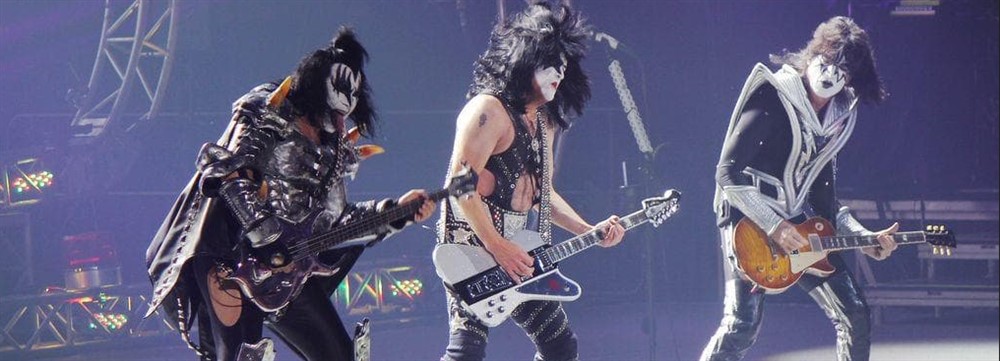
On August 11, 1999, Kiss was inducted into the Hollywood Walk of Fame, in the "Recording Industry" category. The next month, the group worked in collaboration with World Championship Wrestling to produce a Kiss-themed wrestler known as the Demon, whose face was painted to resemble Simmons' makeup. The group performed "God of Thunder" live on WCW Monday Nitro to debut the character. The band received $500,000 for the one-night, one-song performance.
Kiss launched a U.S. Farewell Tour in March 2000. The group quickly added dates to the tour, which ran through April 2001.
"The Reunion tour made us the number one band again. We played to about two million people in one year. Then we did the Psycho Circus tour and after that we thought, "been there, done it, We're the champs again, let's retire on top and we felt there is nothing worse than having someone go away and you don't get to say goodbye so this tour really is for the fans and to celebrate the whole history of the band." — Paul Stanley
Source: Wikipedia

